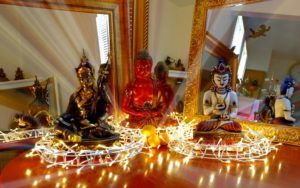
What Are Mantras ?

A Mantra is mystical energy encased in a sound structure. Every Mantra contains within its vibrations a certain power. Upon concentration and repetition of a given Mantra, its energy is elicited and takes form.
Mantra Yoga is an exact science. Mananat trayete iti Mantrah — ”By the constant thinking of Mantra, one is protected and released from the round of births and deaths.” A Mantra is so called because it is achieved by the mental process. The root “man” in the word Mantra comes from the first syllable of that word meaning “to think” and “tra” from “trai” meaning “to protect or free” from the bondage of the phenomenal world. A Mantra generates the creative force and bestows eternal Bliss. A Mantra when constantly repeated awakens the consciousness.
Japa, or Mantra Yoga, is that practice by which the power contained within Mantras is applied for specific purposes.
Mantras are a series of words, traditionally in Sanskrit, that are used to focus the mind on the desired goal.
They can be used to create a positive habit, reduce stress, or increase confidence.
Mantras are Vedic Hymn, sacred sound vibrations that can be used to focus and direct thought and energy.
It creates the sense of armor when recited and increases the alpha frequency and reduces the anxiety in a person. More Read here (Mantras)
Each Mantra is constructed from a combination of sounds derived from the fifty letters of the Sanskrit alphabet. Sanskrit is also known as Devanagari, or language of the gods. The ancient sages, who were in-tuned to higher levels of consciousness, were well aware of the inherent power contained in sound, and they utilized combinations of sounds to set up specific vibrations. These vibrations applied systematically could literally move mountains.


There are different types of Mantras. Some, called bija or seed Mantras, are such that they have no exact meaning. They act directly on the nadis, or nerve tubes of the astral body. They vibrate in the chakras along the spine, acting as a subtle massage, releasing blockages and allowing the kundalini energy to flow more freely. In these the name and form of the sound are merged and cannot be separated. There are also Mantras that have meaning which can be translated. These nirguna or abstract Mantras also set up powerful vibrations in the body, but verbally assert union with unmanifest pure consciousness.


More common, however, is the deity Mantra, in which a specific form with attributes is visualized along with the repetition of the sound.
For example, a reclusive person bent on destroying his negative qualities would repeat a Siva Mantra. A family person, whose ideal was to be a loving and responsible husband or wife, might meditate on the name of Rama. An individual who sees God as infinite, all-loving, and even a little playful would build these qualities in himself by repeating a Krishna Mantra.
Repeating Mantras which are the names of deities internalizes the power of the vibrations that are contained ih the name. When the name of Siva is repeated with concentration, the sound actually breaks down one’s lower qualities. Long ago, Siva was explained in a mythological way; now, scientists explain that when energy breaks down, it forms patterns, it dances. This is the same as the dance of Siva.

